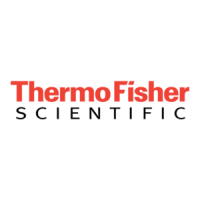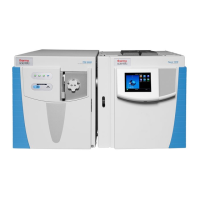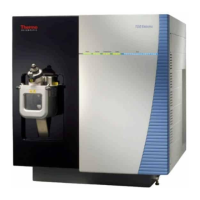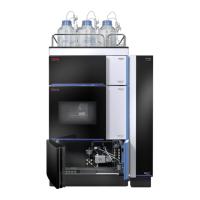Do you have a question about the Thermo Scientific TSQ Quantum XLS and is the answer not in the manual?
Provides important safety warnings and general notices for instrument operation.
Covers the core instrument responsible for ionization and mass analysis.
Describes the component responsible for ionizing sample molecules.
The core component that separates ions by mass-to-charge ratio.
The system that detects and amplifies the ion signal.
Instructions for immediate power-off in critical situations.
Steps for a full shutdown of the system for extended periods or maintenance.
Procedures to follow to restart the system after a full shutdown.
Detailed steps to power on and initialize the mass spectrometer.
How to reset the instrument's embedded computer to a default state.
Procedures for cleaning parts of the ion source to maintain performance.
Specific steps for cleaning the ion volumes.
Procedures for cleaning the ion source lenses if performance issues persist.
Steps to remove the entire ion source assembly for maintenance.
Instructions for replacing the ion source filament when it fails.
Procedures for cleaning stainless steel components of the ion source.
Procedures for replacing the GC capillary column.
Procedures for testing the instrument's electronic circuits.
Common system problems and their solutions.
Identifies and resolves problems caused by contamination.
Addresses drops in instrument sensitivity and their causes.
Addresses problems encountered during auto tune and calibration procedures.
Provides important safety warnings and general notices for instrument operation.
Covers the core instrument responsible for ionization and mass analysis.
Describes the component responsible for ionizing sample molecules.
The core component that separates ions by mass-to-charge ratio.
The system that detects and amplifies the ion signal.
Instructions for immediate power-off in critical situations.
Steps for a full shutdown of the system for extended periods or maintenance.
Procedures to follow to restart the system after a full shutdown.
Detailed steps to power on and initialize the mass spectrometer.
How to reset the instrument's embedded computer to a default state.
Procedures for cleaning parts of the ion source to maintain performance.
Specific steps for cleaning the ion volumes.
Procedures for cleaning the ion source lenses if performance issues persist.
Steps to remove the entire ion source assembly for maintenance.
Instructions for replacing the ion source filament when it fails.
Procedures for cleaning stainless steel components of the ion source.
Procedures for replacing the GC capillary column.
Procedures for testing the instrument's electronic circuits.
Common system problems and their solutions.
Identifies and resolves problems caused by contamination.
Addresses drops in instrument sensitivity and their causes.
Addresses problems encountered during auto tune and calibration procedures.
| Mass Analyzer Type | Triple Quadrupole |
|---|---|
| Polarity | Positive and Negative |
| Detector | Discrete dynode electron multiplier |
| Mass Resolution | 0.7 Da (unit mass resolution) |
| Ion Source Types | ESI, APCI |
| Data Acquisition Modes | Selected Reaction Monitoring (SRM), Product Ion Scan, Precursor Ion Scan, Neutral Loss Scan |
| Dynamic Range | >5 orders of magnitude |
| Scan Modes | Full Scan, SIM, SRM, Product Ion Scan, Precursor Ion Scan, Neutral Loss Scan |
| Precursor Ion Selection | Unit mass resolution |
| Collision Cell | Hexapole collision cell |
| Power Requirements | 100-240 V, 50/60 Hz |
| Operating Temperature | 15 to 30 °C |
| Operating Humidity | 20-80% (non-condensing) |











